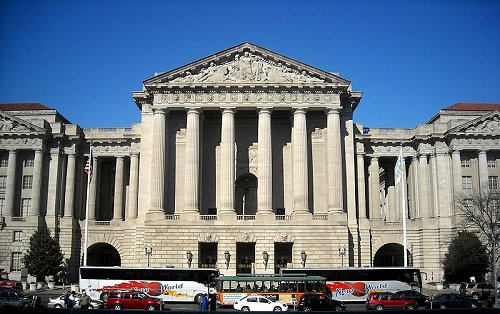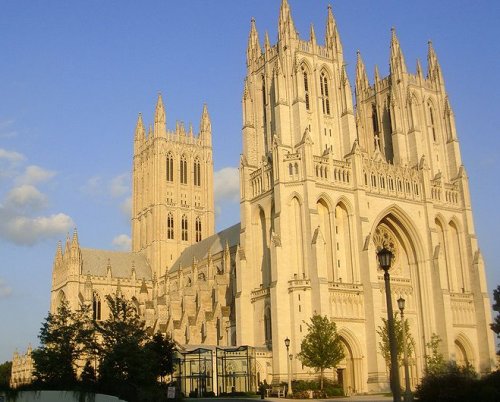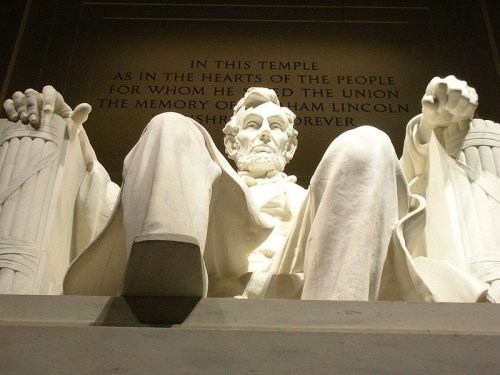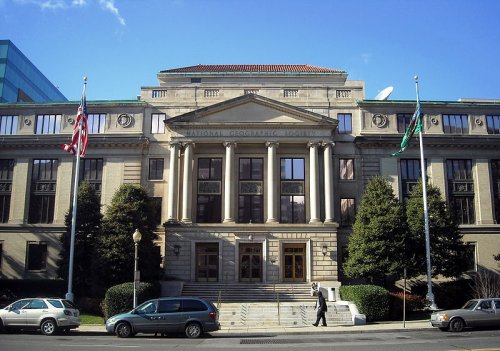

Washington DC
 Go Back - Latest PENANG Sights/Streets/New Properties > Malaysia > World | Hokkien : Lessons : Dictionary | YouTube | Facebook | About Me : Contact Me
Go Back - Latest PENANG Sights/Streets/New Properties > Malaysia > World | Hokkien : Lessons : Dictionary | YouTube | Facebook | About Me : Contact Me United States Capitol Building, Washington, D.C.
United States Capitol Building, Washington, D.C. http://commons.wikimedia.org/wiki/File:Capitol_building_over_reflecting_pool_-_desc-long_shot_-_from-DC1.jpg
http://commons.wikimedia.org/wiki/File:Capitol_building_over_reflecting_pool_-_desc-long_shot_-_from-DC1.jpg Phyzome
Phyzome
Washington, D.C. is the capital of the United States of America. It was created on 16 July, 1790, for the very purpose of being the capital of the newly independent country. The city is located within the District of Columbia, an entity created in 1871 by merging the originally separate City of Washington and the Territory of Columbia into a single municipality.
 Andrew W. Mellon Auditorium, Washington, D.C.
Andrew W. Mellon Auditorium, Washington, D.C. http://commons.wikimedia.org/wiki/File:Andrew_W._Mellon_Auditorium_-_Washington,_D.C..jpg
http://commons.wikimedia.org/wiki/File:Andrew_W._Mellon_Auditorium_-_Washington,_D.C..jpg AgnosticPreachersKid
AgnosticPreachersKid
Washington, D.C. is sited on the northern bank of the Potomac River. It is bordered by Virginia on the southwest and Maryland on northwest, northeast and southeast. The city is headed by a mayor and a 13-member city council.
It was James Madison who pushed for the setting up of a federal district, saying that the national capital has to be distinct from the states so as to provide for its own maintenance and safety. The need became more apparent when an angry mob attacked the Congress building in Philadelphia in 1783. On 16 July, 1760, the decision (through the Residence Act) was made that the capital should be sited on the Potomac River, and that the president, George Washington, was to choose the exact location.
Demarcation of the borders of Washington, D.C. was carried out in 1791-92 - many of the boundary stones are still standing today. The city was originally square, with each side being 10 miles wide, on both sides of the Potomac River. It was named in honor of George Washington. The district itself was named Territory of Columbia, as the name Columbia was another name that the new nation was known as. In 1801, the Territory of Columbia, which includes the cities of Washington, Georgetown and Alexandria, came under the control of Congress.
 Washington National Cathedral
Washington National Cathedral http://commons.wikimedia.org/wiki/File:DCA_08_2009_National_Cathedral_6981.jpg
http://commons.wikimedia.org/wiki/File:DCA_08_2009_National_Cathedral_6981.jpg Mario Roberto Duran Ortiz
Mario Roberto Duran Ortiz
The people living within the Territory of Columbia had since 1800 complained that the creation of the capital district robbed them of voting rights and representation. With the creation of the new territory, they were now neither the residents of Maryland nor Virginia. The protest became more boisterous in the 1830's when the county of Alexandria went into economic decline, partly due to neglect by Congress. In 1840 the residents petitioned that the southern territory be returned to Virginia. As a result, the part of Washington south of the Potomac River went back to Virginia on 9 July, 1846.
Washington enjoys a humid subtropical climate. The spring and fall in Washington are warm, with low humidity. Its winters are cool. July is the warmest month, with average temperature rising to 88.3°F (31.3°C). The coldest month is January, with average temperature dropping to to 27.3°C (-2.6°C).
Travel to Washington DC
There are three major airports in the Washington area.The Ronald Reagen Washington National Airport (DCA) is the nearest of the three, being just across the Potomac River. To reduce noise level in the city, the airport only take flights from within 1,250 miles. If you arrive at this airport, you can take the Metro underground train (Yellow and Blue lines).
Washington Dulles International Airport is the main international airport serving Washington D.C. However it is located 26 miles away. If you arrive at this airport, take the Washington Flyer coach to the West Falls Church Metro Station. The journey takes 25 minutes and costs $10 one way. From the Metro station, you can take the 5A Metrobus to downtown Washington. That's another 25 minutes.
The Baltimore-Washington International Thurgood Marshall Airport is the farthest away, being 30 miles northeast of Washington D.C. It is closer to Baltimore, being just 10 minutes away. The budget way to reach Washington DC from this airport is to take the B30 Express Metrobus. It costs just $3.10 one way and takes 30 minutes. The Metro rail service takes 25 minutes.
 Lincoln Memorial
Lincoln Memorial http://commons.wikimedia.org/wiki/File:Lincoln_Memorial_4.jpg
http://commons.wikimedia.org/wiki/File:Lincoln_Memorial_4.jpg UpstateNYer
UpstateNYer
Travel within Washington DC
Washington DC is split into four quadrants namely NW, NE, SE and SW, all centered on the Capitol Building. Addresses follow the quadrant name, i.e. 1000 H st NE.The Washington Metropolitan Area Transit Authority manages the buses and trains in the city. The Metro is the subway train network in Washington DC. There are five color-coded subway lines in the Washington Metro.
The Washington Metro follows a complicated fare system that varies according to distance as well as day and time of day (!) If you plan to use the Metro a lot, buy the flat-rate Metro pass that allows you to take unlimited number of rides over a set number of days. Then you don't have to go through the hassle of finding out the fare for each ride.
 National Geographic Society Administrative Building, Washington, D.C.
National Geographic Society Administrative Building, Washington, D.C. http://commons.wikimedia.org/wiki/File:National_Geographic_Society_Administration_Building.jpg
http://commons.wikimedia.org/wiki/File:National_Geographic_Society_Administration_Building.jpg AgnosticPreachersKid
AgnosticPreachersKid
Places of Interest in Washington DC
- United States Capitol
Grand Neo-classical building that is the meeting place of the United States Congress. - Library of Congress
The largest library in the world. - US Supreme Court
Judicial branch of the US government. - The Mall
Boulevard between the Capitol and the Washington Monument. - National Air & Space Museum
Museum chronicling the history of aviation. - National Gallery of Art
Museum established when American financier Andrew Mellon bequeathed his collection of European art. - National Museum of Natural History
A huge museum with 120 million artifacts from the world's diverse cultures. - National Museum of African Art
Museum, much of it located underground, exhibiting a 7000-piece permanent collection of modern and ancient art from Africa. - National Museum of American History
Museum housing artifacts from America's past. - Smithsonian American Art Museum & National Portrait Gallery
Housed in the former US Patent Office building, the art museum contains works by American artists. The National Portrait Gallery houses paintings, sculptures, etchings and photographs of famous Americans. - Washington Monument
170-meter (555-feet) obelisk built from 1848 to 1884. - National World War II Memorial
7.5-acre memorial to honor US soldiers and civilians involved in the war. - United States Holocaust Memorial Museum
Museum commemorating the six million Jews and those deemed undesirable by the Third Reich. - Jefferson Memorial
Neo-Classical-style memorial to Thomas Jefferson, the third president of the United States. - Franklin D. Roosevelt Memorial
Memorial in the form of a park with four open-air rooms, documenting Roosevelt's four terms in office. - Lincoln Memorial
Neo-Classical building with the statue of a seated Abraham Lincoln. - Vietnam Veterans Memorial
Memorial designed by 21-year-old Yale University studen Maya Lin comprising two triangular black walls set into the earth. - The White House
Official residence of the President of the United States. - Renwick Gallery
Museum exhibiting 20th century American crafts from every material. - Corcoran Gallery of Art
Collection of fine art originally housed in the Renwick Gallery, founded by William Wilson Concoran. - The Kennedy Center
National cultural center with three main theaters. - Watergate Complex
A complex of apartments, offices and shops that was linked to the scandal that brought down the Nixon administration. - Georgetown
Older than Washington itself, today Georgetown is one of its most attractive neighborhoods. - Phillips Collection
One of the finest collections of Impressionist art in the world. - National Zoological Park
National zoo established in 1887 on a sprawling 163-acre park. - Washington National Cathedral
The world's sixth largest cathedral. - Arlington National Cemetery
Graves of 300,000 American servicemen killed in the major wars from the Revolution to the present. - The Pentagon
The world's largest office building housing a workforce of 23,000.
National Monuments in the District of Columbia
 Latest updates on Penang Travel Tips
Latest updates on Penang Travel Tips
 Discover with Timothy YouTube Channel
Discover with Timothy YouTube Channel
 PG Food Channel
PG Food Channel
 Learn Penang Hokkien YouTube Channel
Learn Penang Hokkien YouTube Channel
 SojiMart Videos
SojiMart Videos
Latest from Discover with Timothy: Gurney Bay - what to see and do there
About this website

Hello and thanks for reading this page. My name is Timothy and my hobby is in describing places so that I can share the information with the general public. My website has become the go to site for a lot of people including students, teachers, journalists, etc. whenever they seek information on places, particularly those in Malaysia and Singapore. I have been doing this since 5 January 2003, for over twenty years already. You can read about me at Discover Timothy. By now I have compiled information on thousands of places, mostly in Peninsular Malaysia and Singapore, and I continue to add more almost every day. My goal is to describe every street in every town in Malaysia and Singapore.
Robbie's Roadmap
- Episode 1: Robbie's Journey to Financial Freedom
- Episode 2: Lost in America
- Episode 3: The Value of Money
- Episode 4: The Mentor
- Episode 5: The Thing that Makes Money
- Episode 6: The walk with a Billionaire
- Episode 7: The Financial Freedom Awakening
- Episode 8: Meet Mr Washington
- Episode 9: The Pizzeria Incident
Copyright © 2003-2024 Timothy Tye. All Rights Reserved.